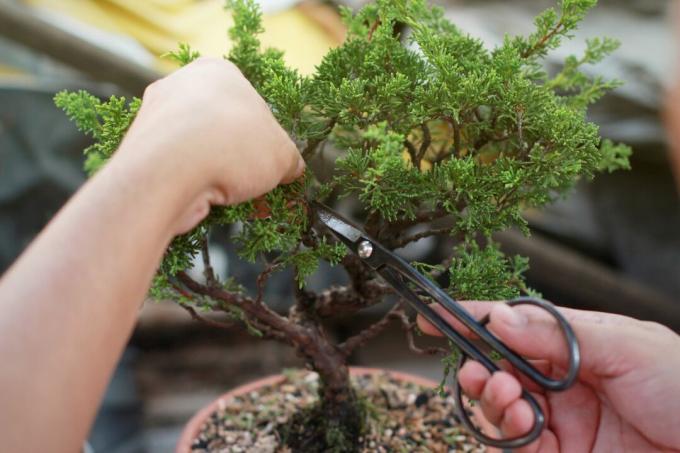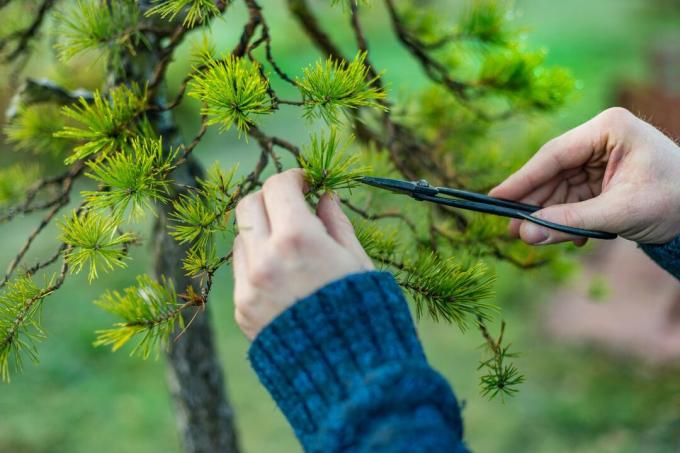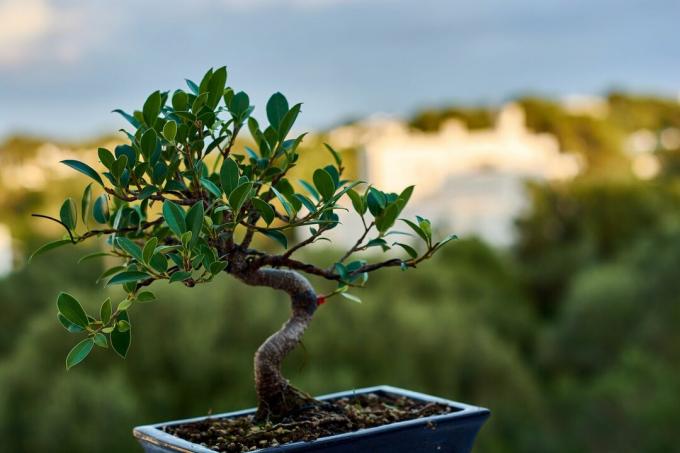There are numerous types of decorative mini-trees. We show how and when to cut bonsai correctly and what to look out for with the different shapes and varieties.

Cutting a small tree as a bonsai - the Japanese art form of tree design needs to be learned and so has its pitfalls. But even beginners can learn how to cut correctly. We will teach you the basics, i.e. everything you need to know about the first cut, about maintenance, leaf and root cutting and when it is time to cut back the bonsai. Following this article, you will find useful guides for three popular types of bonsai.
contents
- Pruning bonsai: basics
- When and how often should a bonsai be cut?
-
The correct approach to pruning bonsai
- The maintenance pruning of bonsai
- The design cut for bonsai
-
The right cut for every type of bonsai
- Cut ficus as a bonsai
- Pruning pine as a bonsai
- Pruning maple as a bonsai
Pruning bonsai: basics
When cutting bonsai, a distinction is made between the maintenance cut and the design cut. While the maintenance cut only preserves and refines the existing shape of the bonsai, the design cut serves to train the small tree to its picturesque shape. Both are carried out by hand, as neither a small indoor bonsai nor a large garden bonsai should ever make the acquaintance of a hedge trimmer.
A common misconception is that bonsais are special dwarf forms of their large relatives. In fact, however, these are completely normal types of plants, which are kept small by small planters and precisely cut. The biggest problem to be overcome is always the apical dominance. The Latin word "apex" denotes the tip of something and the apical dominance means the stronger growth of the shoot tips. This growth behavior is very important for woody plants in nature in order to quickly grow in height and width To be able to absorb sunlight over as large an area as possible and not be shaded by adjacent competitors will. The targeted suppression of the apical dominance makes it possible to create tree miniatures that appear to have a natural growth.

When and how often should a bonsai be cut?
The design cut is only carried out if the shape of the bonsai is to be redefined for the first time or afterwards. Because strong branches are removed and the overburdening of the interfaces means a great effort and loss of water for the plant, the process takes place Design pruning only as required and in early spring before the leaves shoot or in late autumn after the leaves have shed - the same applies to evergreen plants Times. In addition, the design pattern should be limited to just one pattern per year.
The maintenance cut is always used when new shoots have emerged, i.e. very regularly and - depending on the type of plant - almost all year round. The cut constantly removes the shoot tips, which because of the apical dominance mentioned above would otherwise suppress the growth of the lower-lying shoots. Regular pruning ensures even, dense growth - not just above, but on all levels of the plant along the stem axis.
The correct approach to pruning bonsai
Not every cut is the same. We will explain the procedure for the maintenance cut and the design cut to you in detail below.
The maintenance pruning of bonsai
The regular pruning is the real reason that the bonsai tree can be kept in its miniature form. It is possible and necessary during the entire growth period of the plants. With pointed, sharp bonsai scissors, only the tips of the new shoots are regularly cut off individually. You can also remove whole new shoots if they don't fit into the overall picture.
But be careful with conifers like Pinus (Jaw) or Larix (Larch): They do not cut with sharp scissors, but "pinch": with tweezers or with pointed fingers they are The tip of the shoot tends to be twisted off or torn off, because the use of scissors leads to brown needles and the plants cannot tolerate them well will.
It is important that only the soft, freshly grown shoot axes are removed in the care cut - larger cutting actions are preferred to a suitable date for the design cut postponed.

Tip: leaf cut
The leaf pruning can be carried out on deciduous trees in early summer and has the aim of producing smaller leaves and stimulating branching. Small leaves simply go better with the reduced shape of the plant. When cutting leaves, all or only part of the leaves are removed except for the petiole. The newly emerging leaves are smaller in size. However, not all deciduous trees tolerate leaf pruning, and only healthy plants that cannot just had to experience a repotting or a design cut should be burdened with it will.
The design cut for bonsai
The design cut in combination with the wire forces the wood, which has been trained as a bonsai, into the shape desired by the designer. Bonsai made from seedlings or cuttings will only grow normally after a few years subjected to a design cut for the first time - albeit in its relatively tiny bonsai bowl relocate. Now the future bonsai comes with one for the first time Special soil for bonsai in contact that wasn't absolutely necessary before. This first cut and all subsequent design cuts are usually carried out in early spring or late autumn and in no case more than once a year.
Even decades-old, tall wild plants can be turned into a picturesque garden bonsai through careful treatment and an annual design cut.
Strong knots are also removed during shaping. In order to promote the overflow of the resulting wounds, it is important to work properly with the right tools - if possible, concave forceps - and to use a wound closure paste.
When designing your bonsai, your individual creativity is required - you decide what shape your work of art will later have. Deciding which branch to stay and which to remove is not always easy. We have therefore listed a few important basic rules for the design pattern for you, which you can grapple with.
- First remove all dead branches and twigs as well as annoying dead leaves in order to have a clear view of your tree.
- Strong branches that grow vertically and cannot be corrected by tying them down and using wires must be removed.
- If two branches arise on the same trunk at the same height, choose one and remove the other.
- Remove one or more branches if they cross.
- Leave thicker branches at the bottom than at the top - this creates a natural-looking crown.
- Now remove all branches that you think do not “fit into the picture” - you should always pay attention to the view from all perspectives in order to obtain an all-round aesthetic shape.

Tip: cut bonsai roots
Quite a few bonsai experts advise shortening the roots after a design cut. This seems logical, because otherwise the plant will deflect even more strongly after the design cut in order to restore the correct relationship between root and shoot. However, if the roots were reduced at the same time, this reaction is slowed down somewhat. In any case, it makes sense to carry out the design cut together with the obligatory root cut when transplanting. Incidentally, when repotting the bonsai, it is extremely important to use it more appropriately Special soil for bonsai. This ensures a balanced supply of water and oxygen to the plant roots so that they can grow optimally and stay healthy.

The right cut for every type of bonsai
To give you a good orientation, we will introduce you to three types of bonsai and the appropriate cutting techniques. For this purpose, we have selected a houseplant from warm climates, a conifer and a deciduous tree.
Cut ficus as a bonsai
Of the Cowardly (Ficus) different types can be grown as bonsai. The following applies to everyone: if you want a strong trunk, you can Ficus Let it grow freely for two years at the beginning of the upbringing, because it can tolerate the radical design cut that is necessary afterwards without any problems. Subsequent regular pruning is essential - otherwise the tree will quickly lose its shape again. At the latest when six to eight new leaves have emerged on a shoot, a new maintenance cut should be made. Some species have unsuitably large leaves, but because the Ficus- Species also tolerate the leaf cut well, the leaf size can be easily adjusted. The happy one Ficus regenerates well and also drives out of the old wood, but large interfaces should be treated with wound closure paste.

Pruning pine as a bonsai
Also from the pine (Pinus) several species are suitable to be raised as a bonsai. When pruning, it is important to know whether the species in question sprouts new needles once or twice a year: species with two Sprouts per year are in early to midsummer on the newly developed shoots (called "candles") except for a few needles shortened. In addition, buds higher up on the shoot are cut at the top in order to provoke them to grow out in the second shoot. If the second shoot has taken place in autumn and is ripe, superfluous shoots can be removed. This includes, for example, all but two, if a very large number of shoots arise from a single point, and shoots that grow vertically. Finally, by plucking out old needles, the vigor can be slowed down a little.
For species with only one shoot per year, the new candles are only slightly shortened in early or midsummer, and excess shoots can already be selected. You should especially remove vertically growing shoots. The old needles of these pines can also be plucked out in autumn to slow down their growth.
Tip: Just the species Pinus thunbergii (Japanese black pine) and Pinus densiflora (Japanese red pine) sprout twice a year. All other species are limited to one shoot per year.
Pruning maple as a bonsai
The often picturesque growing maple bonsai (Acer) should be cut with care. Although it is possible to cut shoots and small branches all year round, a design cut should be made in the Take place in autumn or summer in order to avoid excessive leakage of water ("bleeding") and nevertheless a rapid overflow support financially. Acer is prone to fungal infections, which is why a wound closure agent should be applied quickly whenever possible. The somewhat sensitive maple can only tolerate leaf pruning in summer every two years - or annually if only some of the leaves are removed. Here it is advisable to remove noticeably large leaves or to deliberately defoliate areas that are too vigorous in order to slow down their growth.
which Fertilizing your bonsai required, you will find out in this special article!
Many thanks to Floragard for their support!



